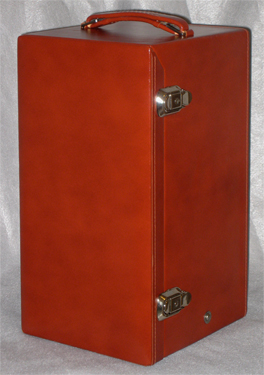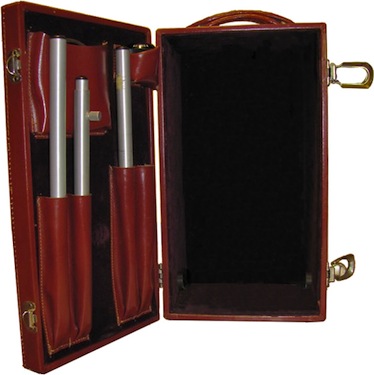Questar Distribution
![]() News
News ![]() Notes & Interesting Articles
Notes & Interesting Articles ![]() Overview
Overview ![]() Pricing
Pricing ![]() Products
Products ![]() Service or Repair
Service or Repair
Questar Telescopes ![]() LD Surveillance Systems
LD Surveillance Systems ![]() LD Microscopes
LD Microscopes ![]() Accessories
Accessories


Leather Case For Questar 3-½ Telescopes 1968 to early 1980's
Among the accessory items that were provided with each new Questar 3-1/2 astronomical telescopes.This replaced the original Leather Case design of 1954, and predates the current Deluxe Leather Case.
This article is provided as a courtesy by Company Seven for those customers who have helped to keep us in business.
 Background: The Questar telescope has since 1954 been recognized as an elegant and refined practical tool for astronomy: the Rolls-Royce of telescopes. Among the accessories that distinguished the Questar was the custom fitted rigid case provided as a standard accessory with each new astronomical telescope. The Questar telescope slides into the larger portion of the case, while the door interior has pouches sewn in to accommodate those accessories that were provided with the Questar.
Background: The Questar telescope has since 1954 been recognized as an elegant and refined practical tool for astronomy: the Rolls-Royce of telescopes. Among the accessories that distinguished the Questar was the custom fitted rigid case provided as a standard accessory with each new astronomical telescope. The Questar telescope slides into the larger portion of the case, while the door interior has pouches sewn in to accommodate those accessories that were provided with the Questar.
Right: Questar 3-½ 1970's Leather Case, final version with angled top/lid, as sold from 1970 through 1982 in Company Seven's Museum Collection (75,137 bytes)
Click on image to see enlarged view (240,846 bytes).
The original Leather Case provided with each new Questar 3-½ telescope was manufactured in England. This 1954 to 1968 production case was assembled of stitched Saddle Leather, with the interior fully lined in wine red velvet. This leather is pliable and without any additional interior bracing, yet the layered leather is rigid enough to retain its shape and hold the seven pound Questar 3-½ safely for casual transit.
By the Spring of 1968 the original English made saddle leather case was phased out and replaced by a rigidly framed leather case manufactured in the USA. The new case was not simply an effort to duplicate the original but this case differs from its predecessor in several ways most notably by providing the telescope better protection against impact and the elements. This case is rigid consisting of a wood frame with sewn and glued leather covering, but with an opening door and latch arrangement and with pouches to store the accessories similar to that provided with the original case. Inside the case door are pouches fashioned of leather as were the original case, these pouches hold the standard accessories then provided with the telescope. The interior of the case is fitted with glued-in panels covered with a dark burgundy red velour fabric.
 There are two versions of this case, the first version sold from 1968 to 1970, and the later production model that was delivered from 1970 to 1982. The latter version is shown at the right in this article, and since more Questars were sold in their era the latter is more commonly seen. The first version of these cases is distinguished from the final production model by the cut of the door; the early case has a conventional box style door and case joint that is rectangular while the later production cases have a case top that tapers over to the forward most edge of the case lid.
There are two versions of this case, the first version sold from 1968 to 1970, and the later production model that was delivered from 1970 to 1982. The latter version is shown at the right in this article, and since more Questars were sold in their era the latter is more commonly seen. The first version of these cases is distinguished from the final production model by the cut of the door; the early case has a conventional box style door and case joint that is rectangular while the later production cases have a case top that tapers over to the forward most edge of the case lid.
Left: open Questar 3-½ 1970's Leather Case. This shows the first production version with squared top/lid, as sold from 1968 through 1970 (34,992 bytes)
These two case arrangements made in the USA for Questar by the Chick Luggage Company of New York. This appealed to the ambitions of Questar's founder, the late Lawrence Braymer, and his wife Peggy to make the Questar an entirely Made in The USA commodity. In the late 1970's the Chick Luggage Company went out of business and this leather case was dropped from the product line altogether. Questar provided their remaining stock of these cases with new telescopes until a vinyl-clad case was sourced.
Years later in response to prodding by Company Seven and possibly some at Questar too, Earlene Austin the President of Questar at the time agreed to revisit the idea of providing a leather clad case. In 1990 a prototype leather case was made (now displayed in Company Seven's Museum Collection), and in 1991 the Deluxe Leather Case was made available as an upgrade option in place of the standard vinyl case when ordering a new Questar Questar Standard or Duplex astronomical telescope. The Deluxe Leather Case is provided as standard equipment with the limited production Questar 50th Anniversary Model telescope.
Arrangement: The case holds the Questar telescope securely with all its standard accessories neatly tucked away in pouches so that they will not fall out in routine transport. The accessories provided with the telescope: Tripod Legs, Solar Filter, Spare Eyepiece, AC Power Cord, and two keys for the Excelsior Latch Locks. These items store in leather pouches that are sewn onto the interior of the door lid.
The case is laid out well and remained compact, and although heavier than its predecessor it weighs less than those that followed it. Aside from its framed construction there are other aspects that differentiate it from the prior model case and some of these make it technically a superior arrangement:
- With its framed construction this case offers better protection to the telescope.
- There are hemispherical shaped metal pads attached to the bottom of the case at each corner and so the leather remains slightly elevated any flat surface it is placed upon. This makes it less likely that the bottom could be worn or stained than the original leather case.
Two of the four pads are attached to the bottom of the case lid, and lacking support at the front right corner this can make it a bit awkward to install or remove the telescope since the case tends to tilt forward a bit.
- The door is hinged by mechanical hardware and so this arrangement too is superior (technically if not aesthetically) to the original case. And out of consideration for aesthetics - maybe just old fashioned craftsmanship, the hinges were first held onto the wood frame then the case was covered in leather, and only after that were the hinge rivets attached so that only these rivets and the hinge pin show from the outside. The interior velour was applied afterwards so that no rivets show inside.
- Rollers made of Synthane (an early laminated phenolic) are attached to either side of the case interior, these grasp the flange of the Questar telescope Base holding it in place securely. The hole drilled and tapped in these disks is off center, so when these are installed onto the case the disks can be rotated to adjust how they bite onto the flange of the Questar base.
As with the prior case the door lid is secured by two nickle plated steel spring loaded keyed laches. But keep in mind these locks only serve to keep the honest person honest. Anyone who really wants to get in can handily walk off with the Questar in the case and force these latches to the breaking point.
Since even the carrying case is appreciated by Questar owners many telescopes were ordered with an optional protective cover to protect the case. This was made of a sewn simulated leather vinyl clad fabric covering whose appearance and brown color tone approximates that of the leather case. The cover featured a tailored fit so that the case is slid in through the open flap lid and this is secured by two snap fasteners.
Unlike later cases, this predates the Powerguide and its successor the Powerguide II Drive Control System so there is no space in the case specifically provided for the Powerguide's Control paddle.
Care and Precautions: This is a good grade of real leather and so it is subject to scuffing or rot if handled or stored inappropriately. We do not recommend setting the case in wet ground while observing for example. Some precautions:
- The leather should be periodically wiped down with leather cream or polish, this will keep the leather supple and prevent deterioration of the leather.
- Pay special attention to insure the Carrying Handle and the bottom are treated generously with a lubricating leather conditioner. This will keep these areas supple and prevent cracking of the leather, and resist staining.
- If the leather becomes covered with dew, it is a good idea to wipe it down with a clean cloth and allow it to dry out in a climate controlled environment.
- When the Questar becomes covered with dew or frost, then it can be placed in the case for safe keeping. But as soon as it is practical, one should allow the case and telescope to acclimate to room temperature, then open the case and remove the telescope thereby allowing both the case and telescope to air out.
Company Seven has serviced Questar 3-½'s fifty years old where their original leather case still appears beautiful and has been well cared for. However, Company Seven recommends those people who will be on the go quite a bit, or store the telescope in high humidity environments, or expose their case to corrosive seashore salt air (near breaking surf), or extended periods in sunlight should opt for the standard vinyl case. We have some customer who want to have the entire Questar experience of a leather case, appealing to their sense of tradition, while also ordering a vinyl case to have it at times when they do not wish to risk damaging their leather case!
| Case Exterior Dimensions | 8-¾ inches deep x 8-¼ wide x 15-1/8 tall 222 x 210 x 384 mm |
| Case Height To Top of Handle | 16-¾ inches / 400 mm |
| Case Weight (with keys) | 4 lb. 15.9 oz / 2 kg. 264 g |
| Locking Latch | Two, keyed with spring loaded latch |
| Origin | Made in USA |
We invite you to visit our showroom near Washington, D.C. to see a Questar first hand or contact us by E-mail to info@company7.com, or by telephone 301-953-2000. The showroom is open Monday to Friday 11 am to 6 pm, Saturday 11 am to 5 pm. We are closed on Sundays, on U.S. Holidays, and from 25 December through 1 January inclusive.
Contents Copyright 1994-2012 Company Seven, All Rights Reserved

